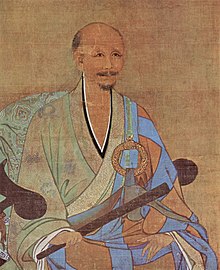Wuzhun Shifan
| Wuzhun Shifan | |
|---|---|

Portrait of Zen master Wuzhun Shifan, painted in 1238, Song Dynasty.
|
|
| Religion | Ch'an |
| Personal | |
| Nationality | Chinese |
| Born | 1178 Sichuan Province, China |
| Died | 1249 |
| Senior posting | |
| Title | Ch'an-shih |
Wuzhun Shifan (Chinese: 無準師範; Wade-Giles: Wu Chun Shih Fan; 1178–1249) was a Chinese painter, calligrapher, and prominent Zen Buddhist monk who lived during the late Song Dynasty (960-1279).
Wuzhun Shifan was born in Zitong, Sichuan province, China. He eventually became a Buddhist abbot at the Temple of Mount Jingshan. He was once summoned by Emperor Lizong of Song (理宗; r. 1224-1264) in 1233 in order to share with him the doctrine of Chán (Zen) Buddhism, discussing Dharma with the emperor. For this Wuzhun was given the title Fojian Yuanzhao Chanshi (Mirror of the Buddha, Zen Teacher) as well as a gold-embroidered kaśaya that he wears in his portrait painting of 1238.
Wuzhun had many disciples who studied under him. This included Enni Ben'en (圓爾辯圓 ; 1201–1280; Shoichi Kokushi), who studied under Wuzhun in China from 1235 to 1241 and later brought Wuzhun's teachings to Japan. Afterwards, Enni helped cement greater acceptance for Zen teaching in Japan and aided in the establishment of the Tōfuku-ji temple of Kyoto in 1243.
Some of Wuzhun's written calligraphy that was handed down to Enni is still preserved on plaques found at Tōfuku-ji, and a scroll of Wuzhun's calligraphy was even presented to the Tokugawa family as a gift to the Shogun. There is also a written letter of Wuzhun Shifan, dated to 1242, that is now preserved as a national treasure of calligraphy at the Tokyo National Museum.
...
Wikipedia
